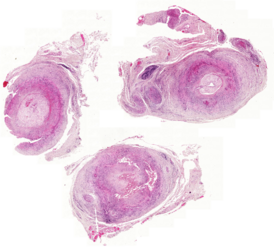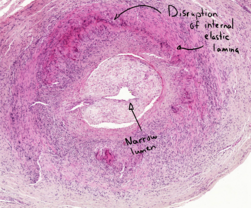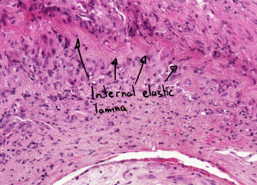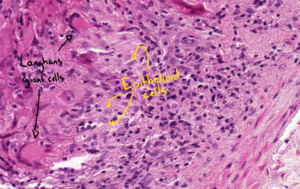41. Arteritis temporalis: Difference between revisions
(Created page with "'''Staining''': HE '''Organ''': Superficial temporal artery '''Description''': Three cross-sections of an artery can be seen. The upper right one is the easiest to examine. We can see giant cells, epithelioid cells, lymphocytes and plasma cells. The lumen of the artery is really narrow and the internal elastic lamina is disrupted. '''Diagnosis''': Temporal arteritis, a form of giant cell arteritis '''Etiology''': * Older people * Females more affected than males '...") |
No edit summary |
||
| (7 intermediate revisions by the same user not shown) | |||
| Line 1: | Line 1: | ||
'''Staining''': HE | [[File:Temporal arteritis overview.png|thumb|Overview of the slide|274x274px]]'''Staining''': HE '''Organ''': Superficial temporal artery | ||
'''Organ''': Superficial temporal artery | |||
'''Description''': | '''Description''': | ||
Three cross-sections of an artery can be seen. The upper right one is the easiest to examine. We can see giant cells, epithelioid cells, lymphocytes and plasma cells. The lumen of the artery is really narrow and the internal elastic lamina is disrupted. | Three cross-sections of an artery can be seen. The upper right one is the easiest to examine. We can see giant cells, epithelioid cells, lymphocytes and plasma cells. The lumen of the artery is really narrow and the internal elastic lamina (IEM) is disrupted. | ||
''' | '''Diagnosis''': Temporal arteritis, a form of giant cell arteritis[[File:Temporal arteritis disruption of the IEM.png|thumb|Upper right section. The dark irregular purplish lining shows the disruption of the IEM.|251x251px]]'''Risk factors''': | ||
* Older people | * Older people | ||
* Females more affected than males | * Females more affected than males | ||
'''Theory''':[[File:Temporal arteritis IEM.png|thumb|Also from the upper right section.|257x257px]]Giant cell arteritis, or temporal arteritis (when it affects the temporal artery) is a granulomatous inflammation that affects large arteries. Characteristic for the disease is that only certain parts of the affected artery show the histological signs of inflammation. If a preparation was taken from one of these parts could a false negative diagnosis be made. Optimally should a longitudinal section of the artery be examined, or multiple cross-sections (which could be why we have three sections here).[[File:Temporal arteritis giant cells.png|thumb|From the upper right section. The cells with small cytoplasm and dark nuclei are lymphocytes and plasma cells|none]] | |||
'''Theory''': | |||
Giant cell arteritis, or temporal arteritis (when it affects the temporal artery) is a granulomatous inflammation that affects large arteries. Characteristic for the disease is that only certain parts of the affected artery show the histological signs of inflammation. If a preparation was taken from one of these parts could a false negative diagnosis be made. Optimally should a longitudinal section of the artery be examined, or multiple cross-sections (which could be why we have three sections here). | |||
[[File:Temporal arteritis giant cells.png | |||
Latest revision as of 12:34, 5 July 2024

Staining: HE Organ: Superficial temporal artery
Description:
Three cross-sections of an artery can be seen. The upper right one is the easiest to examine. We can see giant cells, epithelioid cells, lymphocytes and plasma cells. The lumen of the artery is really narrow and the internal elastic lamina (IEM) is disrupted.
Diagnosis: Temporal arteritis, a form of giant cell arteritis

Risk factors:
- Older people
- Females more affected than males
Theory:

Giant cell arteritis, or temporal arteritis (when it affects the temporal artery) is a granulomatous inflammation that affects large arteries. Characteristic for the disease is that only certain parts of the affected artery show the histological signs of inflammation. If a preparation was taken from one of these parts could a false negative diagnosis be made. Optimally should a longitudinal section of the artery be examined, or multiple cross-sections (which could be why we have three sections here).

